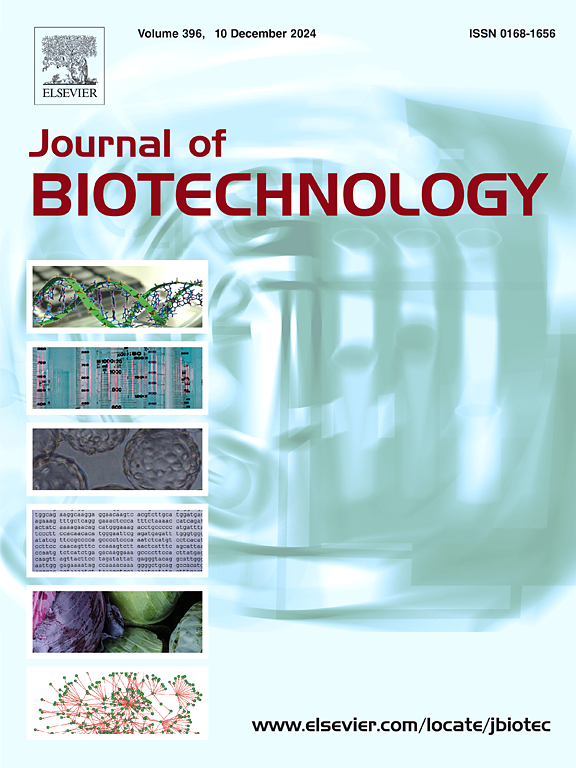用连续亲和捕获改进AAV8的纯化:从批处理到连续多柱色谱。
IF 3.9
2区 生物学
Q2 BIOTECHNOLOGY & APPLIED MICROBIOLOGY
引用次数: 0
摘要
基因治疗中对腺相关病毒(aav)的需求日益增加,这推动了更有效和可扩展的纯化工艺的发展。本研究探索了使用Resolute®BioSMB PD平台纯化AAV8亲和树脂的不同批次和连续多柱色谱(MCC)方法。从对突破行为的描述开始,我们通过将单个色谱床划分为更小的连接柱来定义连续加载策略。这种连续批多柱色谱(B-MCC)过程随后被修改为一种版本,其中柱过载以提高生产率和树脂利用率。比较了不同方法的回收率、生产率、缓冲液消耗和树脂利用率。与B-MCC工艺相比,开发的连续顺序多柱色谱(S-MCC)工艺具有更高的AAV回收率,在最高负载浓度下回收率为76%,产率为1.8×1017 VP hr-1 mL-1,是B-MCC工艺的1.5倍。此外,对于相同体积的加工饲料,与B-MCC相比,S-MCC的缓冲消耗减少了一半。我们的研究结果表明,S-MCC显著提高了整体工艺效率,在降低资源消耗的同时提供了更高的回收率和生产率。这些结果有力地支持了连续加工技术在生物制药行业的广泛应用,特别是对AAV等高需求生物制品的应用。本文章由计算机程序翻译,如有差异,请以英文原文为准。
Improving AAV8 purification with continuous affinity capture: From batch to continuous multicolumn chromatography
The increasing demand for adeno-associated viruses (AAVs) in gene therapy is driving the development of more efficient and scalable purification processes. This study explored different batch and continuous multicolumn chromatography (MCC) approaches for AAV8 affinity resin purification using the Resolute® BioSMB PD platform. Starting with a description of the breakthrough behaviour, we defined a continuous loading strategy by dividing a single chromatography bed into smaller, connected columns. This continuous batch multicolumn chromatography (B-MCC) process was then modified into a version where the columns were overloaded to enhance productivity and resin utilization. The different approaches were compared regarding recovery, productivity, buffer consumption, and resin utilization. The continuous sequential multicolumn chromatography (S-MCC) process developed enables higher AAV recovery in comparison to the B-MCC process, with a recovery of 76 % for the highest load concentration evaluated, with a productivity of 1.8 × 1017 VP h−1 mL−1, 1.5 times higher than the B-MCC. Additionally, for the same volume of processed feed, the S-MCC halves the buffer consumption compared to the B-MCC. Our results demonstrate that S-MCC significantly improves overall process efficiency, offering higher recovery and productivity while reducing resource consumption. These results strongly support the broader application of continuous processing techniques in the biopharmaceutical industry, particularly for high-demand biologics such as AAV.
求助全文
通过发布文献求助,成功后即可免费获取论文全文。
去求助
来源期刊

Journal of biotechnology
工程技术-生物工程与应用微生物
CiteScore
8.90
自引率
2.40%
发文量
190
审稿时长
45 days
期刊介绍:
The Journal of Biotechnology has an open access mirror journal, the Journal of Biotechnology: X, sharing the same aims and scope, editorial team, submission system and rigorous peer review.
The Journal provides a medium for the rapid publication of both full-length articles and short communications on novel and innovative aspects of biotechnology. The Journal will accept papers ranging from genetic or molecular biological positions to those covering biochemical, chemical or bioprocess engineering aspects as well as computer application of new software concepts, provided that in each case the material is directly relevant to biotechnological systems. Papers presenting information of a multidisciplinary nature that would not be suitable for publication in a journal devoted to a single discipline, are particularly welcome.
 求助内容:
求助内容: 应助结果提醒方式:
应助结果提醒方式:


